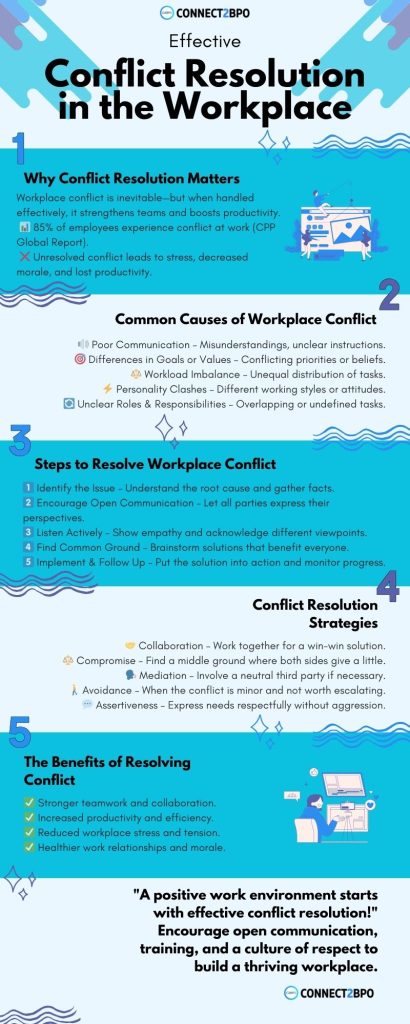Conflict in the workplace is inevitable, but how it’s managed can make or break team dynamics, productivity, and overall job satisfaction. Understanding conflict resolution in the workplace and implementing effective strategies can transform workplace disputes into opportunities for growth, collaboration, and innovation.
In this guide, we’ll explore conflict resolution strategies, define what conflict resolution is, and provide practical techniques to handle disputes effectively.
What is Conflict Resolution? (Conflict Resolution Definition)
Conflict resolution is the process of addressing disagreements between individuals or groups in a constructive manner. The goal is to resolve disputes in a way that maintains relationships, fosters mutual respect, and improves overall teamwork.
Why is Conflict Resolution Important in the Workplace?
- Enhances communication and collaboration.
- Reduces stress and workplace tension.
- Improves employee engagement and productivity.
- Fosters a more positive work environment.
- Prevents escalation into more serious issues.
Common Causes of Workplace Conflict
Before implementing solutions, it’s essential to understand what causes workplace conflicts. Some common sources include:
- Poor Communication – Misunderstandings and lack of clarity can lead to conflicts.
- Different Work Styles – Employees have different approaches to work and problem-solving.
- Competing Priorities – Conflicts arise when team members have conflicting goals or deadlines.
- Personality Clashes – Differing personalities and temperaments can create tension.
- Lack of Clear Roles – Ambiguity about job responsibilities can lead to conflicts.
- Unfair Treatment or Favoritism – Perceived inequality in the workplace can trigger disputes.
Top Conflict Resolution Strategies in the Workplace
Addressing workplace disputes requires structured approaches. Here are seven proven conflict resolution strategies to handle disagreements effectively.
1. Active Listening and Open Communication
Effective communication is the cornerstone of conflict resolution. Encourage employees to:
- Listen without interrupting.
- Acknowledge others’ perspectives.
- Ask clarifying questions to avoid misunderstandings.
💡 Example: Instead of assuming a colleague ignored an email, ask if they had a chance to review it.
2. Address Issues Early and Privately
Conflicts that fester can become toxic. It’s crucial to address concerns early and in a private setting to prevent unnecessary escalation.
💡 Tip: Encourage team members to discuss concerns directly with each other before involving management.
3. Use Mediation and Third-Party Intervention
If two employees can’t resolve an issue themselves, mediation with a neutral third party can help facilitate a fair resolution.
💡 Example: An HR representative or team leader can guide a structured discussion between conflicting parties.
4. Focus on Solutions, Not Blame
Instead of pointing fingers, shift the conversation towards resolving the issue.
💡 Example: Rather than saying, “You never meet deadlines,” say, “Let’s discuss how we can ensure project deadlines are met.”
5. Establish Clear Workplace Policies
Companies should have a workplace conflict resolution policy in place, outlining:
- Steps for employees to report conflicts.
- Conflict resolution training programs.
- Guidelines for escalating disputes.
💡 Tip: A well-defined policy creates consistency in handling workplace conflicts.
6. Encourage Empathy and Emotional Intelligence
Employees who understand emotional intelligence (EQ) are better equipped to handle conflicts professionally.
💡 Example: Encourage team members to consider the other person’s perspective before reacting.
7. Implement Conflict Resolution Training
Providing conflict resolution training helps employees develop:
- Negotiation skills.
- Emotional intelligence.
- Problem-solving techniques.
💡 Tip: Many organizations invest in conflict resolution training workshops to build a positive workplace culture.
How to Handle Conflict Resolution in the Workplace: Step-by-Step Guide
When a conflict arises, follow this structured approach:
- Identify the Issue – Understand the root cause of the dispute.
- Listen to All Sides – Give each party an opportunity to express their viewpoint.
- Find Common Ground – Look for areas of agreement to build a foundation for resolution.
- Explore Possible Solutions – Brainstorm ways to move forward constructively.
- Agree on a Resolution – Ensure all parties agree on the next steps.
- Follow Up – Check in to ensure the conflict does not resurface.
Workplace Conflict Resolution: Real-Life Example
Case Study: Resolving a Conflict Between Team Members
Scenario: Two employees, Alex and Jordan, frequently argue over project responsibilities, leading to tension in the team.
Resolution Steps Taken:
- Private Meeting: A manager held a meeting with both employees to discuss concerns.
- Active Listening: Both parties were encouraged to share their perspectives.
- Defining Roles: Clear expectations were set for responsibilities.
- Agreement & Follow-Up: The manager scheduled a follow-up meeting to ensure ongoing cooperation.
Outcome: With clear expectations, communication improved, and the project was completed smoothly.

Benefits of Effective Conflict Resolution
1. Stress Reduction
One of the main benefits of conflict management is reducing stress in the workplace. We have all experienced situations where unresolved tension makes coming to work uncomfortable. You might feel like you are walking on eggshells around certain colleagues.
By developing conflict management skills, teams can create a space where issues are addressed promptly and fairly, preventing them from turning into bigger problems that cause stress.
For example, a team that regularly holds check-ins to discuss any brewing issues is actively managing conflict. These discussions, often led by a neutral party, provide employees with an opportunity to express their concerns openly.
When employees know that their feelings will be validated and not dismissed, they are less likely to feel anxious. Instead, they develop emotional regulation skills that help them stay calm, even in the face of disagreements.
2. Better Decision Making
Effective conflict management also leads to better decision-making. When a team learns how to manage differing viewpoints constructively, they are more likely to explore various options and arrive at well-rounded solutions. Imagine a team meeting where everyone is too afraid to speak up because they do not want to cause conflict. The result? Decisions that do not consider multiple angles can potentially lead to missed opportunities.
However, in a team where conflict management is prioritized, everyone is encouraged to share their opinions, even if they differ. This approach fosters an environment where communication is not only welcomed but seen as necessary.
When people understand that their ideas will be heard without judgment, they are more willing to contribute. This diverse input leads to a better understanding of the issue at hand and enables the team to come up with more mutually beneficial solutions.
3. Fostering Inclusion to Support a Diverse Workforce
Conflicts arise from misunderstandings or differences in perspective, which are inevitable in a diverse workplace. In such environments, conflict management training that incorporates elements of diversity and inclusion can be invaluable.
When employees understand how to navigate conflicts sensitively, they are more likely to view differences as strengths rather than sources of tension. This inclusive approach to conflict resolution training reinforces respect and understanding, encouraging a culture where diverse voices are heard and valued.
Incorporating diversity-focused conflict training allows team members to build empathy, helping them see beyond personal viewpoints to appreciate other perspectives. For example, conflict management training might cover techniques for addressing unconscious biases, providing employees with the tools to engage in constructive conversations even when perspectives clash.
This approach fosters a deeper sense of unity within the team as employees learn to value the unique insights that each individual brings to the table. By building inclusivity into conflict resolution, organizations create a more cohesive, supportive workplace that is well-equipped to handle both differences and disagreements.
4. Team Cohesion
Another important benefit of conflict management is improved team cohesion. You have probably noticed that teams that trust each other tend to work better together. This trust is built when team members know they can disagree respectfully and work through those disagreements in a supportive way.
When conflicts are managed well, they actually bring the team closer together. People learn more about each other’s perspectives, which leads to stronger relationships and a sense of unity.
Consider a scenario where two team members have differing opinions on how to approach a project. Without proper conflict management, this disagreement might lead to resentment or passive-aggressive behavior.
However, in a team that knows how to manage conflicts effectively, this situation can become an opportunity for growth. The parties involved can discuss their viewpoints openly, learn from each other, and work toward a solution that benefits the whole team. Over time, this process deepens the team’s trust and makes them more cohesive.
5. Prevention of Escalated Disputes
Proactively managing conflict helps prevent disputes from escalating into bigger, more damaging issues. Unresolved conflicts can easily spiral into larger problems that impact the entire workplace. You might have seen situations where a simple disagreement turns into a full-blown argument, disrupting productivity and harming relationships. This often happens when people fail to address underlying issues early on.
Conflict management sets up ground rules that help employees address concerns before they get out of control. By fostering an environment where people feel safe to express their concerns, managers can prevent minor issues from snowballing into larger conflicts.
For example, holding regular team meetings to check in on everyone’s feelings can be a way of addressing small tensions before they become significant problems. This proactive approach leads to positive outcomes by nipping potential disputes in the bud and maintaining a healthy workplace environment.
6. Boosting Problem-Solving Skills
Another benefit worth mentioning is the boost in problem-solving skills that comes with effective conflict management. When teams learn to manage conflict, they also learn how to approach problems from different angles.
They become more adept at finding mutually beneficial solutions and navigating complex situations. This skill is invaluable in today’s fast-paced work environments, where challenges arise frequently and require creative solutions.
By regularly engaging in constructive dialogue, employees sharpen their problem-solving abilities, allowing them to handle future conflicts more effectively. This ongoing learning process is a key factor in developing a resilient team that can adapt to various situations.
7. Improves Team Collaboration
As part of the company culture, when employees learn to resolve conflicts effectively, teamwork improves significantly. By fostering an environment where open communication and constructive discussions are encouraged, teams become more cohesive and work together more harmoniously. Instead of letting disagreements create divisions, employees develop the skills to navigate differences while maintaining strong professional relationships.
8. Boosts Productivity
A workplace free from excessive conflict allows employees to focus on their tasks rather than workplace drama. Unresolved disputes can create distractions and lower morale, ultimately impacting efficiency. When conflict management strategies are in place, employees spend less time dealing with tension and more time being productive.
9. Enhances Employee Satisfaction
A fair, respectful workplace environment is a key driver of job satisfaction. When employees feel their concerns are heard and addressed appropriately, they are more engaged and committed to their roles. Organizations that prioritize conflict resolution cultivate a positive work culture that fosters employee well-being and retention.
10. Strengthens Leadership Skills
Managers who develop strong conflict resolution skills become more effective leaders. They learn how to mediate disputes, guide discussions, and encourage teamwork, ultimately fostering a more positive and collaborative work environment. Leaders who handle conflicts proactively contribute to a culture of trust and mutual respect within the organization.
Final Thoughts
Conflict is an inevitable part of the workplace, but how it’s managed makes all the difference. By implementing conflict resolution strategies in the workplace, businesses can foster a more positive, productive, and harmonious environment.
💡 Need help creating a conflict-free work environment? Investing in your company’s culture with conflict resolution training and developing strong communication practices can significantly impact.
Frequently Asked Questions (FAQs)
1. What is conflict resolution?
Conflict resolution is the process of resolving disagreements between individuals or groups by addressing concerns, finding common ground, and working towards a mutually beneficial solution.
2. What are the 5 conflict resolution strategies?
2.1. Avoiding
Avoiding is a conflict resolution strategy best suited for situations where both the relationship and goal hold little significance.
While these cases are uncommon in the workplace, they may arise in daily life. For example, if you’re on a public bus and a passenger next to you is playing loud music, addressing the issue may not be worth the effort since you’ll likely never see them again. Ignoring the disturbance is a reasonable way to avoid unnecessary conflict.
However, in professional settings—where both your objectives and relationships with colleagues are typically important—avoidance can be counterproductive.
Key takeaway: While some conflicts are best avoided, this approach is rarely beneficial in the workplace.
2.2 Competing
The competing approach, though not often recommended for workplace conflicts, can be effective in specific scenarios.
This strategy is most appropriate when achieving your goal takes priority over maintaining relationships. It involves a high level of assertiveness but little cooperation.
A crisis situation is a prime example where competition is useful. If someone is unconscious and bystanders are debating what to do, stepping in and taking charge can expedite medical assistance.
It can also be useful when asserting yourself, especially in situations that threaten your safety. In these cases, prioritizing your well-being over relationships is essential.
However, using a competitive approach in workplace conflicts—where relationships matter—can damage trust, hinder collaboration, and reduce productivity.
2.3. Accommodating
Accommodation is a strategy where you prioritize the other party’s needs over your own. This approach is best suited for situations where maintaining a positive relationship is more important than achieving a particular goal.
For instance, if you propose an idea in a meeting and a colleague strongly opposes it, withdrawing your suggestion may help ease tensions and prevent conflict.
Accommodation is particularly effective in diffusing hostility or when you have no strong preference. However, relying on it too frequently may prevent valuable discussions and limit opportunities for innovation.
As a leader, observe whether your team members tend to default to accommodation. If the environment is conducive to open discussion, fostering constructive debate can lead to better collaboration and stronger ideas.
2.4. Compromising
Compromising involves both parties making concessions to reach a middle ground. Since neither fully achieves their desired outcome, it is often considered a “lose-lose” strategy.
This method is appropriate when both the goal and the relationship hold moderate importance. You value maintaining the relationship but not to the extent of completely sacrificing your objective.
For example, if two colleagues want to lead the same project, they could compromise by co-leading or taking turns managing different projects.
Compromising requires a willingness to see the bigger picture and let go of personal pride. The benefit is that both sides demonstrate mutual respect and a willingness to find a fair resolution.
2.5. Collaborating
Unlike compromise, which results in mutual sacrifice, collaboration aims for a “win-win” solution. This approach is ideal when both the goal and the relationship are equally important, encouraging both parties to find an outcome that satisfies all needs.
A good example of collaboration is addressing an underperforming employee. While maintaining a strong working relationship is crucial, so is improving their performance for the company’s success. Approaching the issue collaboratively allows both sides to identify the root cause and work toward a solution that benefits both the individual and the business.
Collaboration is often the most effective approach in workplace conflicts, as it balances achieving goals with maintaining positive relationships. Encourage collaboration whenever possible, and if a perfect solution isn’t feasible, compromising can serve as a backup strategy.

3. How can conflict resolution training help employees?
Conflict resolution training helps employees develop communication skills, emotional intelligence, and problem-solving abilities to handle disputes effectively.
4. What are the common mistakes in workplace conflict resolution?
- Avoiding conflicts instead of addressing them.
- Focusing on blame rather than solutions.
- Allowing emotions to escalate disputes.
5. How do I implement conflict resolution strategies in my company?
Start by establishing clear policies, providing training programs, and encouraging open communication among employees.
6. What are the best techniques for handling conflict resolution in the workplace?
The best techniques include active listening, mediation, clear communication, and early intervention to prevent escalation.
Take Action Today!
Conflict resolution is a skill every workplace should prioritize. Implement these strategies and watch as your workplace transforms into a more productive, positive, and collaborative environment.


